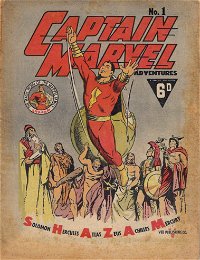Articles
11 October 2010
Larry Cleland by James Zee

In 1946, during the post-war boom in Australian comics, the Vee Publishing Co. entered the market with an extensive programme of US Fawcett reprints. This company became Larry Cleland Pty. Ltd around 1949/50, although Stanley Larry Cleland had been associated with the company since its foundation.
Cleland has no publishing record prior to Vee Publishing, and it is unknown how he secured the rights to Fawcett's material. However, the company quickly expanded its range of black and white reprint editions to include a dozen or more humour, super hero and western comics.
Read more26 August 2010
Frew by James Zee

While The Phantom is Frew Publications' most famous and only remaining comic, from the late 1940s the company also published a wide range of other reprints and original Australian comics.
In 1948, Ron Forsyth, Jim Richardson, Jack Eisen and Peter Watson put in £500 each to found Frew, using an acronym of their four surnames to name the new company—although Eisen and Watson withdrew before the first comic was produced. For the next 40 years, Forsyth and Richardson shaped the company into an Australian icon.
Read more5 August 2010
Newton by James Zee

Newton Comics was a short-lived range of Marvel reprints produced in 1975 and 1976 as part of an excentric publishing empire based around Maxwell Newton's six year run on the trashy tabloid, the Melbourne Sunday Observer.
When publisher Gordon Barton abandoned his Observer in 1971, Newton quickly put out a replacement through Regal Press. The comics were part of a range of magazines and external jobs that kept the presses running throughout the week, not just the two days needed for the Sunday Observer. Other projects included teen mags such as Scream and Sweet, entertainment publications National Tattler and TV Guide, and the pornographic Pleazure, Eros and Kings Cross Whisper.
Read more4 July 2010
International sources by James Zee

Until the 1980s, Australian access to international comics was limited due to a range of factors, including distribution monopolies, exclusive licences, geograpical isolation, cultural bias toward British publications and war-time import restrictions.
During and following the second world war, a thriving local comics industry developed, including the publication of thousands of reprint comics. At the start of the 20th century, British material had dominated the Australian market. The earliest comics were modeled on British weekly newspaper-style comics, until the US format and US sources began to dominate in the 1940s.
Read more29 June 2010
Murray by James Zee

From 1946 until 1983, the K.G. Murray Publishing Company produced comics under a range of imprints—Climax Comics, Blue Star, Colour Comics, Planet Comics and finally Murray Comics.
While most of these were DC reprints, some included original Australian work and reprints from such diverse publishers as ACG, Charlton, Avalon, Novelty Press, Quality, Comic Media, Ziff-Davis, St. John, Ajax-Farrell, Fiction House and Atlas/Marvel. From the late 1960s, some series included translated comics, particularly from Spain's Selecciones Ilustradas agency.
Read more29 June 2010
Various by James Zee

Australian access to international comics was limited until the 1980s, resulting in a strong local comic industry, including reprint comics.
Many of the earliest and most popular Australian comics were based on reprints of newspaper strips, reflecting international trends and later providing an opportunity to circumvent import restrictions. The mid-1930s saw significant expansion of syndicated newspaper material in Australia, particularly following formation of the Yaffa Syndicate to distribute material from King Features Syndicate.
Read more17 June 2010
Federal by James Zee

Between 1983 and 1986, the Federal Publishing Company (FPC) reprinted contemporary DC and Marvel comics, occasionally dipping into a backlist of stories acquired from the K. G. Murray Publishing Company.
FPC was a new publishing division of Hannanprint, formed through the acquisition of leisure and special interest publications from ACP Publishing, the company that acquired Murray from its founding family in 1972. Hannanprint's Eastern Suburbs Newspapers (subsequently ESN The Litho Centre) also became the printers for the comics at that time.
Read more16 June 2010
Page/Yaffa by James Zee

Throughout the 1960s and 1970s, the Yaffa Publishing Group produced a range of mainly reprint comics under "Yaffa" and "Page" imprints or company divisions.
David Yaffa founded his company around 1925 with the publication of Newspaper News (later AdNews), an advertising and marketing magazine. The Yaffa Syndicate's earliest comics involvement was the distribution of newspaper strips from King Features Syndicate (such as Flash Gordon, Brick Bradford and Mandrake the Magician). Page Publications, the imprint of most of Yaffa's comics, was established as a separate entity in the 1960s.
Read more15 June 2010
Horwitz by James Zee

From about 1950 to 1966, Horwitz Publications was a large publisher of war, western and crime comics, including popular titles such as Navy Combat, Fast Gun, Wyatt Earp and Buffalo Bill.
Horwitz predominantly reprinted US comics, sourced mainly from Timely/Atlas/Marvel, but with other US publishers and newspaper strip reprints. In the late 1950s, it created some local comics, notably adaptations of its Carter Brown novels and The Phantom Commando, created by John Dixon but passed to Maurice Bramley (b 1910) who drew it until 1956.
Read more14 June 2010
Gredown by James Zee

From around 1975 to 1984, Gredown published a diverse range of magazine-size comics, predominanly horror but also western, science fiction and other genres. Beginning as sequentially-numbered magazine-size series, the comics later became mainly one-shots with a wildly eccentric range of titles.
Little is know about Gredown's origins, although it seems the company was formed to compete with KG Murray. Greg Murray appears to have established Gredown after his father, Kenneth G. Murray was bought out by Australian Consolidated Press (APC) in 1974. The earliest Gredown publications were magazines, but the company's output was soon focused on reprint comics.
Read more